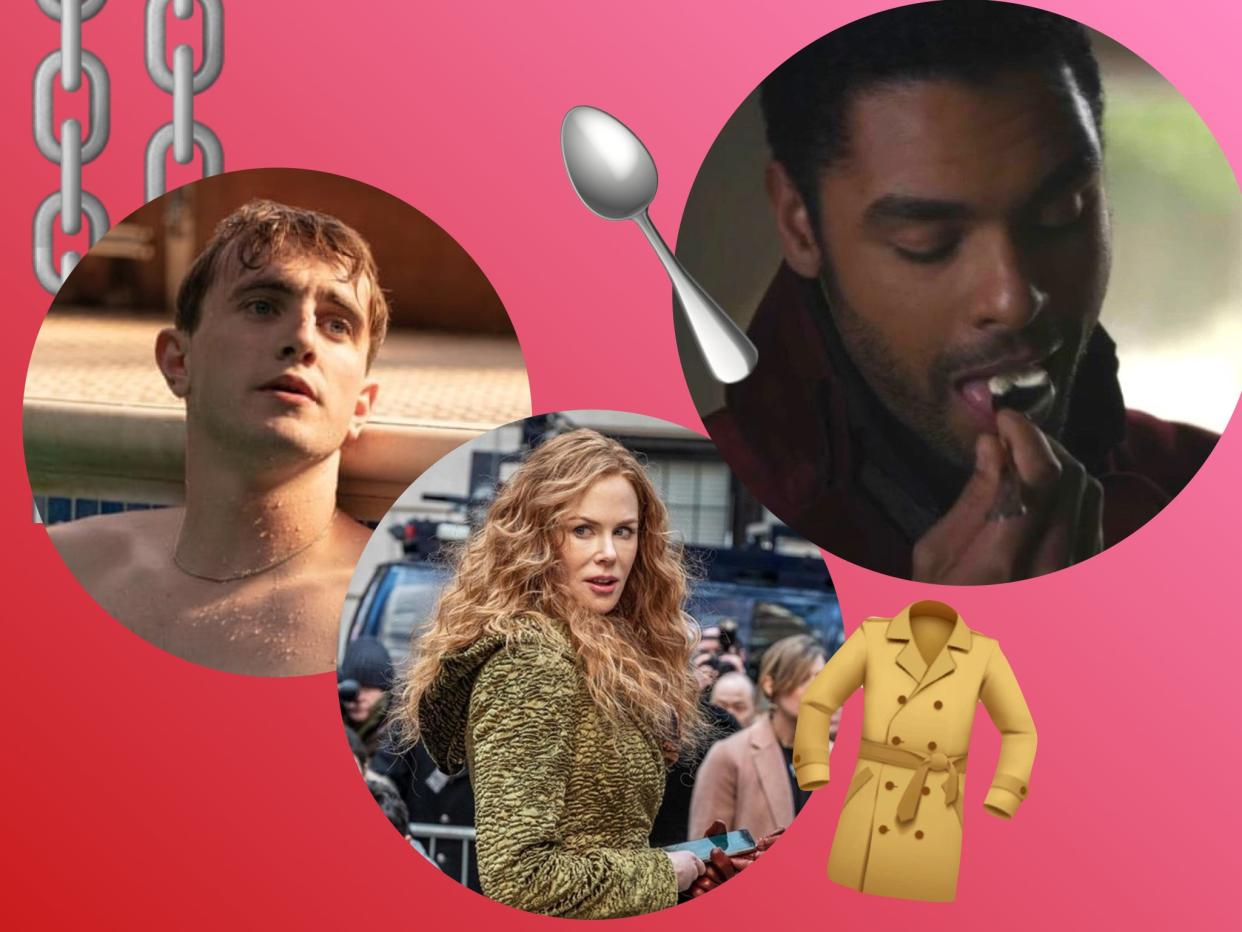From Bridgerton’s spoon to Normal People’s chain – the intimacy of inanimate objects

The most standard televised objects have come to bear a near-supernatural chemistry
(BBC / HBO / Netflix)I have never used the spoon emoji. On the usefulness barometer, the spoon resides somewhere between the non-potable water sign and the aerial tramway. Looking at social media now, though, I see the humble icon everywhere. The reason for the curious case of the spoon’s new status? The Netflix drama Bridgerton. Or more specifically, a five-second scene depicting one of its many good-looking characters (played by Regé-Jean Page) getting intimate with his cutlery.
There is no shortage of steamy moments in Bridgerton. The series, which has been described as Downton Abbey meets Gossip Girl, follows the lives of young, rich, hot people doing young, rich, hot people things set against the backdrop of Regency-era London. The show pulls you in at first glance – its pastel-coloured world is one of delicious candy-floss frivolity. It’s also a bodice-ripper in the most literal sense of the term. Over eight episodes, audiences witness many a corset torn, elbow-length silk glove pried off with teeth, riding boot flung haphazardly in the fray of it all. So it’s against all odds – including a three-minute sex montage soundtracked to an orchestral cover of Taylor Swift’s “Wildest Dreams” – that a silver, run-of-the-mill-looking thing has become the lustful totem of a show known for its abundant lustfulness.
To understand why, we’ve got to look at how. By the time the spoon arrives in episode three, the Duke’s character has been established: he is a charming yet disreputable bachelor, or in Austen-speak a “rake”. His bare bum is also a well-known persona by this point. He and his conspirator-turned-lover Daphne (Phoebe Dynevor) are at a tea shop, colluding on a secret (read: sexy) plan, when the Duke lifts a conspicuously clean spoon to his mouth and proceeds to lick it in a way that no one has ever licked a spoon in normal life. Cue the heavy breathing. In that precise moment, the show’s expansive carnal energy is distilled into this singular unextraordinary object, erotically charged with the power of a thousand heaving bosoms. “Never been so jealous of a spoon before in my life,” is an accurate summation of the Bridgerton discourse on Twitter.
It’s not the first time that a mundane metal object has dominated conversation about a series. Remember Connell’s chain? Last year’s adaptation of Sally Rooney’s novel Normal People – a sad and raunchy love story between two young adults Marianne (Daisy Edgar-Jones) and Connell (Paul Mescal) – was critically acclaimed. But as much as the series was applauded for its interrogation of class and for its realistic depiction of sex on screen, what has remained, swaying hypnotically in our imagination, is Connell’s necklace. The whisper of jewellery draped across Emmy-winner Mescal’s throat stole the show. In Vulture’s rundown of Normal People’s sex scenes, the angle at which viewers are able to “admire Connell’s chain” is a consideration.
Sales of similar accessories on clothing retailer Asos soared by 130 per cent. The phenomena spawned its own Instagram account. A year on from the drama’s debut and @ConnellsChain still has an impressive 177,000 loyal followers. Its founder, journalist Billie Bhatia, astute in the fine art of identifying television’s most niche objects of desire, has likewise created an account for the Duke’s spoon. The profile, whose bio reads: “My spoon, my eyebrow, my cravat, my [peach emoji],” has a modest following of 11, 300 followers – but that number has increased by more than 4,000 just this past weekend.
Last year’s hit drama The Undoing was the talk of the town (and by town, of course, I mean Twitter). Conversation, however, was steered not as much by its performances or even the identity of its murderer as by a particularly divisive coat worn by Nicole Kidman’s character. The coat in question is green and calf-length with wide lapels and a hood – a particularly apt manifestation of “ugly chic”. Although The Undoing didn’t ignite the same thirsty response as Connell’s chain, “the coat” once again illustrated the frenzy-sending power of an inanimate object. Countless articles debated the coat's merit – assessments that ranged from “a standout exemplar or autumnal chic” to “the biggest sin in the programme”.
Amid this enduring lockdown, the most standard televised objects have come to bear a near-supernatural chemistry. It seems that in our relative states of isolation, some semblance of intimacy can be found much closer to home – in a kitchen drawer or a wardrobe. Audiences have approached the aesthetic experience of a series as ecstatic, finding beauty in things at which we’d normally not look twice. The phenomena of the Duke’s spoon and Connell’s chain, in particular, are not merely material projections of our solitary yearnings but exercises in finding meaning and comfort when both seem increasingly out of reach. Or at least, that’s the highbrow way I’m choosing to justify my own weird fascination with spoons.


